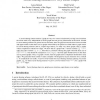Free Online Productivity Tools
i2Speak
i2Symbol
i2OCR
iTex2Img
iWeb2Print
iWeb2Shot
i2Type
iPdf2Split
iPdf2Merge
i2Bopomofo
i2Arabic
i2Style
i2Image
i2PDF
iLatex2Rtf
Sci2ools
CRYPTO
2012
Springer
2012
Springer
Secret Sharing Schemes for Very Dense Graphs
A secret-sharing scheme realizes a graph if every two vertices connected by an edge can reconstruct the secret while every independent set in the graph does not get any information on the secret. Similar to secret-sharing schemes for general access structures, there are gaps between the known lower bounds and upper bounds on the share size for graphs. Motivated by the question of what makes a graph “hard” for secret-sharing schemes (that is, require large shares), we study very dense graphs, that is, graphs whose complement contains few edges. We show that if a graph with n vertices contains n 2 − n1+β edges for some constant 0 ≤ β < 1, then there is a scheme realizing the graph with total share size of ˜O(n5/4+3β/4 ). This should be compared to O(n2 / log n) – the best upper bound known for the share size in general graphs. Thus, if a graph is “hard”, then the graph and its complement should have many edges. We generalize these results to nearly complete k-homoge...
CRYPTO 2012 | Cryptology | Dense Graphs | Independent Set | Vertices |
| Added | 28 Sep 2012 |
| Updated | 28 Sep 2012 |
| Type | Journal |
| Year | 2012 |
| Where | CRYPTO |
| Authors | Amos Beimel, Oriol Farràs, Yuval Mintz |
Comments (0)

